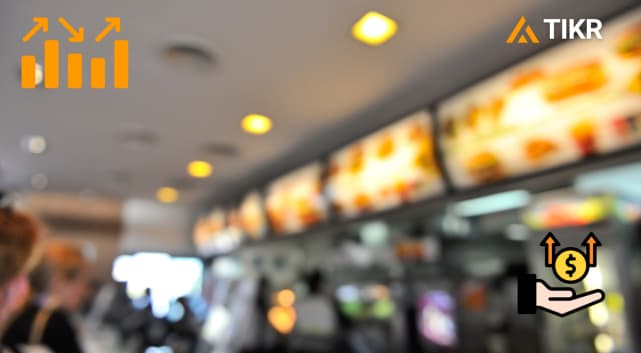BT Group plc (BT.A), the UK’s largest telecommunications provider, better known as British Telecom, delivered mixed results for fiscal year 2025. Total revenue fell 2.1% to £20.4 billion, reflecting softer enterprise demand and the ongoing drag from legacy product declines. But that top-line weakness was offset by strong cost management and a meaningful boost in profitability. Net income rose 23% to £1.05 billion, pushing profit margins up to 5.2% from 4.1% last year, while adjusted EBITDA climbed 1% to £8.2 billion, a sign that BT is learning to do more with less.
Earnings per share increased to 11p (up from 8.7p), supported by lower expenses, operational simplification, and the completion of a major restructuring that merged the group’s Enterprise and Global units into a new “Business” division. The company also reaffirmed its annual cost-savings target of £3 billion by fiscal 2029, achieving 30% of that goal already, a full year ahead of schedule. While top-line momentum is muted, BT is clearly becoming leaner and more focused on value extraction rather than pure expansion.

BT remains a business in transition: steady, defensive, but still contending with macroeconomic headwinds and fierce competition in consumer broadband. The group’s Openreach arm continues to roll out full-fibre broadband across the UK, now reaching 18.1 million premises with an adoption rate of 36%. With nearly 91% of its data now hosted on Google Cloud and the ongoing decommissioning of legacy networks, BT’s digital transformation is starting to show through in its financials and operating agility.
Financial Story: A Reset year, Not a Lost One
Fiscal 2025 showed BT Group at its most disciplined in years. The company’s transformation plan, built on structural simplification, automation, and digitalisation, is beginning to pay off. Annual cost savings reached £842 million as BT continued to rationalise operations and modernise IT systems. That achievement puts the company roughly a year ahead of its original schedule for a £3 billion efficiency programme.
| Metric | FY 2025 | FY 2024 | YoY Change | Commentary |
|---|---|---|---|---|
| Revenue | £20.4 billion | £20.8 billion | ▼ 2.1% | Weakness in Enterprise offset by growth in Openreach |
| Profit Before Tax | £1.33 billion | £1.19 billion | ▲ 12% | Driven by cost savings and lower impairments |
| Net Income | £1.05 billion | £855 million | ▲ 23% | Higher margins and lower expenses |
| Adjusted EBITDA | £8.2 billion | £8.1 billion | ▲ 1% | Cost efficiencies offset inflation pressures |
| Operating Cash Flow | £7.0 billion | £6.0 billion | ▲ 17% | Improved working capital |
| Normalised Free Cash Flow | £1.6 billion | £1.3 billion | ▲ 23% | Ahead of guidance |
| Capital Expenditure | £4.86 billion | £4.88 billion | — | Peak fibre build largely complete |
| EPS (Basic) | 11.0p | 8.7p | ▲ 26% | Reflects cost discipline and improved profitability |
| Dividend (Full Year) | 8.16p | 8.00p | ▲ 2% | Maintained progressive policy |
These efforts helped offset modest revenue declines, as lower energy costs, reduced network expenses, and improved productivity supported margins. Profit before tax climbed 12%, and free cash flow of £1.6 billion exceeded management’s forecast range, giving BT some breathing room after several sluggish years. Importantly, management executed this reset without sacrificing investment in fibre or service quality, a balancing act that positions BT for steadier cash generation.
See BT Group’s full financial results & estimates (It’s free) >>>
Still, BT’s growth ceiling remains capped by legacy network drag and price competition in consumer broadband. The real challenge now is sustaining margin expansion while reigniting top-line growth across both consumer and enterprise units. The outlook for FY 2026 calls for essentially flat adjusted revenue and EBITDA of around £8.2–£8.3 billion, proof that BT has stabilised, but also a reminder that true growth is still to come.
1. Efficiency Is the New Growth Engine?
For a mature telecom operator, efficiency has become BT’s growth engine. The company’s reorganisation of its Enterprise and Global units into a single “Business” division saved £142 million in FY 2025 and laid the groundwork for simpler, faster decision-making. By eliminating duplicate systems and aligning service models, BT is better positioned to respond to customer needs while reducing overhead costs.
Automation is accelerating those savings. BT’s rollout of AI-based network monitoring reduced outage-related manual interventions by 23%, and more than 7,900 business clients have adopted its “ServiceNow” cloud platform. These initiatives, paired with data analytics tools that generate £125 million in annualised value through improved data insights, show how the company is extracting new value from efficiency gains. It’s not flashy, but for BT, incremental optimisation is translating directly into stronger margins and steadier cash flow.
2. Fibre Rollout Nears the Finish Line
BT’s full-fibre investment remains central to its long-term value story. Openreach’s fibre-to-the-premises (FTTP) network now covers 18.1 million locations, up 4.3 million year-over-year, with take-up at 36%. Retail fibre subscribers grew to 3.4 million, and the company reaffirmed its target of 30 million homes and businesses by the end of the decade. That scale advantage has helped cement Openreach as the backbone of the UK’s digital infrastructure.
The heavy lifting is nearly over. With capital expenditure steady at £4.9 billion this year, BT expects a decline of more than £1 billion annually starting in FY 2026 as the fibre build winds down. Those savings, combined with rising wholesale access fees from rival ISPs using the Openreach network, should significantly expand free cash flow. Return on capital employed (ROCE) rose to 8.5% in FY 2025, and management expects it to climb steadily as investment intensity fades and efficiency gains compound.
Value stocks in less than 60 seconds with TIKR’s new Valuation Model (It’s free) >>>
3. Resilient Dividends and Predictable Cash Flow
Despite its reputation as a slow mover, BT has become one of the FTSE 100’s more dependable income plays. The full-year dividend rose 2% to 8.16p per share, underpinned by consistent free cash flow and improving operational execution. Net debt increased modestly to £19.8 billion, but leverage remains stable relative to cash generation and asset value.
BT’s guidance points to continued dividend growth as capital intensity falls and cost transformation matures. Management expects annualised free cash flow to reach £2 billion by FY 2027 and £3 billion by 2030, enough to fund dividends, service debt, and modest share repurchases. That steady cash outlook, combined with a renewed focus on digital operations, gives BT one of the clearest long-term visibility profiles in the UK telecom sector. While growth is limited, predictability has real value in a market this uncertain.
The TIKR Takeaway

BT Group’s turnaround isn’t dramatic, but it’s credible. After years of bloated operations and heavy network investment, the company is finally balancing cost control with a pragmatic investment pace. FY 2025 proved that BT can sustain profitability even without top-line growth, demonstrating that a mature utility can still deliver shareholder returns through discipline and consistency.
The market appears to be recognising that shift. BT shares are up roughly 25% year-to-date, buoyed by optimism that the fibre build is nearing completion and the worst of its cost burdens are behind it. Still, the path ahead will depend on whether the company can turn efficiency into modest growth, particularly in its Business and Consumer units. For now, it’s a story of quiet progress rather than breakout performance, but one that’s building real momentum.
Should You Buy, Sell, or Hold British Telcom?
BT Group looks like a strong consideration for long-term investors. The numbers show improvement across profitability, cash generation, and capital efficiency, even if growth remains modest. The market often undervalues stable cash flow stories like this, especially when dividend visibility is high and debt is contained.
For income-oriented investors, BT offers an attractive yield and improving fundamentals. For those seeking growth, patience is required. The company’s transformation is underway, but the payoff will likely be gradual. In short, BT is finally getting its house in order. The next phase is proving it can thrive, not just survive.
Quickly value any stock with TIKR’s powerful new Valuation Model (It’s free!) >>>
AI Compounders With Massive Upside That Wall Street Is Overlooking
Everyone wants to cash in on AI. But while the crowd chases the obvious names benefiting from AI like NVIDIA, AMD, or Taiwan Semiconductor, the real opportunity may lie on the AI application layer where a handful of compounders are quietly embedding AI into products people already use every day.
TIKR just released a new free report on 5 undervalued compounders that analysts believe could deliver years of outperformance as AI adoption accelerates.
Inside the report, you’ll find:
- Businesses already turning AI into revenue and earnings growth
- Stocks trading below fair value despite strong analyst forecasts
- Unique picks most investors haven’t even considered
If you want to catch the next wave of AI winners, this report is a must-read.
Click here to sign up for TIKR and get your free copy of TIKR’s 5 AI Compounders report today.
Looking for New Opportunities?
- See what stocks billionaire investors are buying so you can follow the smart money.
- Analyze stocks in as little as 5 minutes with TIKR’s all-in-one, easy-to-use platform.
- The more rocks you overturn… the more opportunities you’ll uncover. Search 100K+ global stocks, global top investor holdings, and more with TIKR.
Disclaimer:
Please note that the articles on TIKR are not intended to serve as investment or financial advice from TIKR or our content team, nor are they recommendations to buy or sell any stocks. We create our content based on TIKR Terminal’s investment data and analysts’ estimates. Our analysis might not include recent company news or important updates. TIKR has no position in any stocks mentioned. Thank you for reading, and happy investing!





